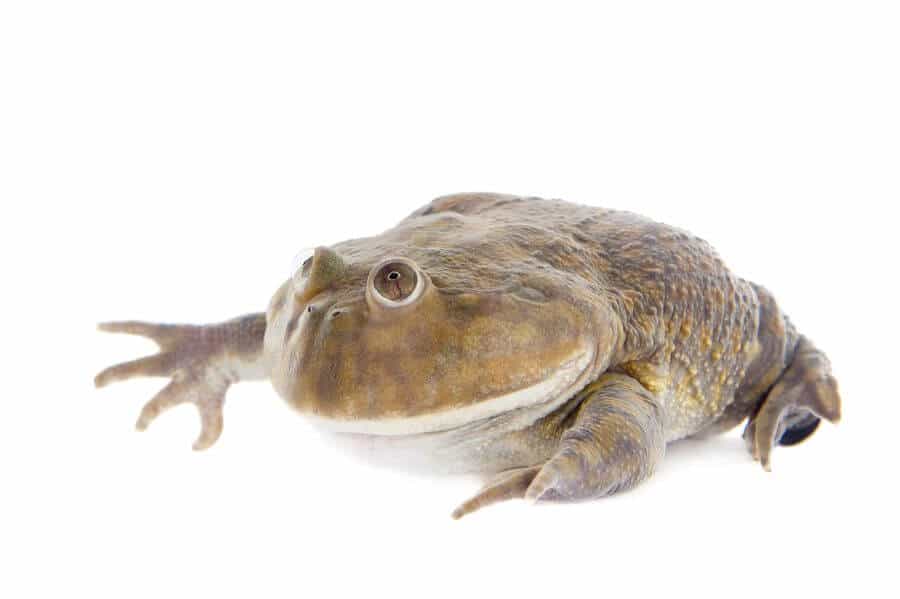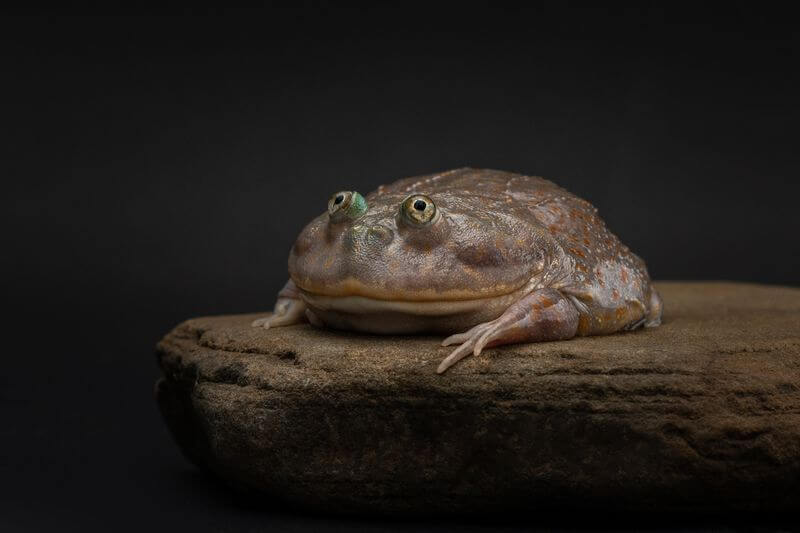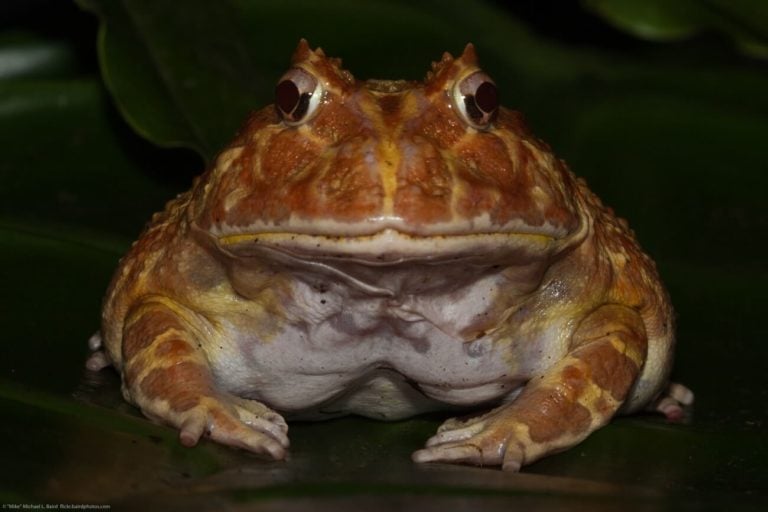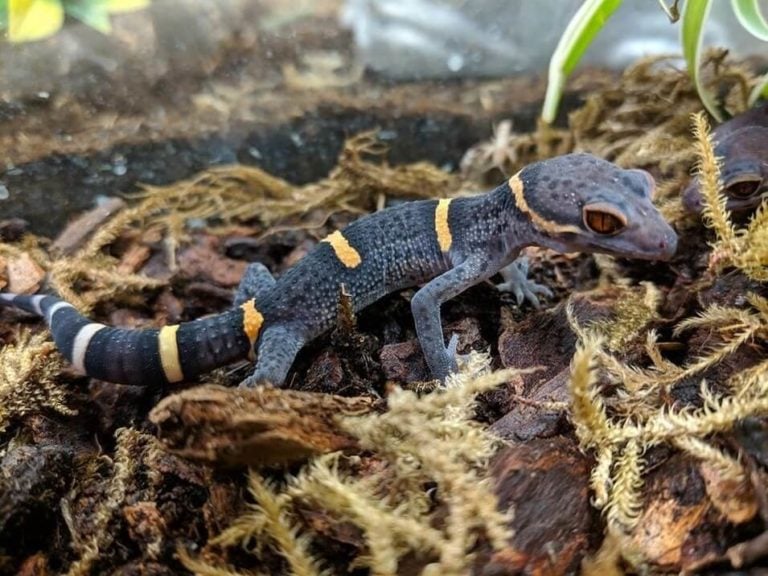Budgett’s frogs are unique pet amphibians that have quite a striking (and silly) appearance. But make no mistake, they’re a lot of fun to own!
This guide will teach you everything you need to know about Budgett’s frog care, so you can help your pet thrive.
Table of Contents
Species Summary
Budgett’s frogs (Lepidobatrachus laevis) are a quirky little amphibian growing in popularity in the pet trade. Known for their distinct and somewhat goofy appearance, they’re a beloved reptile going viral online for its strange behavior and looks.
This frog gets its name from the man who discovered it, Samuel Budgett. Budgett was looking for lungfish but managed to stumble across this frog in Argentina. It’s native to many countries in South America, including Bolivia, Paraguay, and Argentina.
It also goes by common nicknames like the “Hippo Frog” and “Freddy Krueger Frog.”
Budgett’s frogs typically reside near bodies of water, such as temporary pools created during the rainy season. These frogs are prominent in Chaco, a semiarid lowland of the Rio de Plata Basin.
You can get a Budgett’s frog from many pet stores around the world. Both wild-caught and captive-bred frogs are available. Most herpetology buffs recommend going with captive-bred frogs due to the minimized risk of diseases and parasites.
Appearance & Colors
The most striking thing about Budgett’s frogs is their odd appearance.
This amphibian has a large flat body and a massive head that takes up about a third of its body. It’s also sporting a huge mouth. Their mouths play a big part in how it hunts, lunging forward to swallow prey hold. When they’re not eating, their mouths are so big that they almost look like a cartoon smiling back at you!

On top of the flat head are two round eyes. The positioning of the eyes is unique. Despite the large and round profile, the frog’s eyes sit close together at the top of the head.
Below the eyes, you’ll see two nostrils.
The strange position of the eyes and nostrils helps the frog sit calmly below the water’s surface. Their eyes and nostrils poke above the waterline as they sit and wait for food to pass by.
This frog has muted coloration. Most adults have a greenish-gray color. Some specimens may also be pinkish-gray. It’s common to see irregular olive or brown spots throughout its backside.
On the belly, the frog is predominantly white or gray.
The legs are short and stubby. While the hind legs are webbed, the forelegs aren’t.
Expert Tip: Males and females look nearly identical at first glance. However, females are much larger than their male counterparts, and size is often the only differentiator when sexing this species.
Lifespan
There’s no way to guarantee how long your pet frog will live, and the Budgett’s frog is no different. But the good news is that the average lifespan of a Budgett’s frog is 15 to 20 years.
Of course, how long they live depends on many factors, some of which are out of your control. The best thing you can do is provide the best care possible to help your frog live a long and healthy life.
Average Size
The average size of a Budgett’s frog is about 5.5 inches for females and 3.5 inches for males. Females are always the bigger of the two. Some females can even reach 6 inches long!
Budgett’s Frog Care
There’s no doubt that this amphibian is unique. However, it can also be a handful. Generally, the pet trade considers Budgett’s frog care to be ideal for intermediate-level owners.
They have many distinct requirements and demanding environmental needs that many novices will struggle with. Here’s what you need to know about caring for a Budgett’s frog.
Enclosure Size
One of the most challenging aspects of caring for a Budgett’s frog is creating an environment that accommodates the amphibian’s unique lifestyle. These frogs come from an area with distinct dry and wet seasons. During the wet rainy season, they live in small pools. But when it’s dry in the winter, they go dormant underground.
While the frog might be small, you must create a habitat with ample room.
For an adult Budgett’s frog, you need an enclosure at least 30 inches wide, 12 inches tall, and 12 inches deep. A standard 30-gallon aquarium is a good starting point. Those dimensions are the bare minimum, but it’s always good to go bigger if you can.
Height isn’t a big priority with Budgett’s frogs. They’re not big climbers. However, you need an aquarium that can hold water. For most people, that’s a simple fish aquarium. However, you can also use a vivarium with front-facing doors if there’s ample depth for water.
What To Put In Their Habitat
When designing a Budgett’s frog habitat, you must model it from the animal’s natural habitat. Because of how these frogs live, that means creating both dry land and swimming.
Start with a substrate material. You have two options. Many herpetology buffs like to use large river rocks. However, you can also use a mix of reptile-safe soil substrate and coconut coir. For the best results, you can use both.
Whatever you do, avoid pebbles and small rocks. Budgett’s frogs are notorious for gulping down those materials and experiencing compaction issues. If you use soil and coconut coir, install a feeding dish so your frog doesn’t accidentally ingest the material.
As mentioned earlier, you need to create swimming and land areas. The best way to do that is to create a slope. You can use your substrate material or a plexiglass sheet to differentiate the zones and provide easy access between them.
Consider using your river rocks for the water area and slope while limiting the land area to the soil/coir mix.
The water side of the enclosure should be substantial. Your Budgett’s frog needs room to submerge its entire body and swim around underwater. It doesn’t have to be massive, but there should be enough room for the frog to take advantage of both dry and wet zones.
In the dry area, add several inches of substrate. Most Budgett’s frogs won’t burrow themselves during the winter when living in captivity. However, they might dig around. A few inches of substrate will allow them to do that comfortably.
Once the land and water areas are established, add several hide boxes on the substrate. You can use ceramic pots, cuts of PVC pipe, and even old boxes. Whatever you use, smooth the edges of the hide’s entrance to avoid accidental injury.
Temperature & Lighting
The ideal ambient temperature for a Budgett’s frog enclosure is in the mid-70s. Aim for about 75 degrees Fahrenheit.
This species is fairly tolerant of modest fluctuations. For example, they won’t mind if it moves to the low-70s or high-70s. However, you need to monitor the temperature regularly to ensure that the enclosure doesn’t get hotter than 80 degrees Fahrenheit.
Expert Tip: Eighty degrees and above can be fatal for these frogs. It’s wise to install a digital thermometer to keep track of ambient temperatures throughout the day.
Depending on where you live, you might need to install heating devices to keep temperatures above 70 degrees at night. In that case, you can use heat emitters or under-tank heating pads.
For lighting, a standard fluorescent bulb used for tank aquariums is fine. Set the light on a 12-hour timer to mimic the lighting schedule outside.
Budgett’s frogs are nocturnal. They spend most of the day relaxing in hides before emerging at night. Because they’re nocturnal, these frogs don’t need UVB lighting. However, they require the 12-hour light cycle to maintain their circadian rhythm.
Humidity
Like most amphibians, Budgett’s frogs need relatively humid environments to stay healthy. This species prefers humidity levels between 60 and 70 percent.
Maintaining high humidity isn’t too difficult because the enclosure includes a swimming area. However, you must invest in a hygrometer to maintain the ideal levels. It’s also a good idea to use an enclosure with adjustable ventilation to lower the humidity if things get too high.
If you live in a cold or dry area, it may be worth buying an automatic mister or in-tank humidifier. Otherwise, regular misting with a spray bottle can do the trick.
Water
In addition to maintaining ambient air temperatures and humidity, you must pay attention to the water in the swimming area.
Amphibians like the Budgett’s frog can absorb toxins through their skin. Therefore, you must fill the tank with dechlorinated water. Many great water conditioners are available that can remove harsh metals that could impact your frog’s health.
A good temperature range for the swimming area is 76 to 82 degrees. Install an additional underwater thermometer to monitor this parameter. If it gets cold where you live, consider installing an aquatic heater as well.
Budgett’s frogs can produce considerable waste. Regular cleaning and water changes are paramount. You also need to have a water filtration system.
A standard hang-on-back filter will work well if it can reach the waterline. There are several great compact filters available for reptiles that require swimming areas. They are smaller than the average fish tank aquarium, and you can install them lower in the tank to reach the water if necessary.
Ideally, you should siphon out waste daily. It’s also wise to do partial water changes once a week to keep the aquatic conditions in good shape.
Food & Diet
This goofy-looking frog species looks harmless, but it’s a natural-born predator. It’s carnivorous and requires a good diet of insects to stay healthy. Interestingly enough, they’re even carnivorous in their tadpole stage!
Budgett’s frogs aren’t picky. They will consume anything that fits into their mouth. Remember: This species has an enormous mouth, so they have no problems consuming most traditional frog foods. They also have healthy appetites.
In the wild, Budgett’s frogs are ambush predators. They sit below the water, poking their nostrils and eyes above the waterline. When prey swims by, they lunge forward and swallow food!
This frog does have strong jaws, so it can easily chew on most things. The frog also has large toothlike ridges on its top jaw. On the bottom, they have two sharp fangs.
The best diet for Budgett’s frogs in captivity is centered around insects. Good food items include:
- Crickets
- Dubia roaches
- Hornworms
- Earthworms
- Wax moth caterpillars
You can also provide the occasional fish. Many owners like to treat their frogs to guppies. Other occasional snacks you can try include:
- Shrimp
- Locusts
- De-shelled land snails
- Lumbricus worms
- Sardines
- Chunks of whitefish
Insects should be the staple, but you can add a few treats into the mix.
When you source insects, always buy them from a pet store. You want gut-loaded insects raised in controlled environments. Never catch wild bugs and feed them to your frog. Wild-caught insects could carry diseases and parasites that harm your frog’s health.
If your Budgett’s frog is still young, feed it four to five times weekly. You can provide enough food that the frog is willing to eat in about 15 minutes. Remove any leftovers from the tank when it stops eating to avoid ruining conditions.
As your frog ages, you can decrease the frequency of feedings to three times a week and transition to slightly larger insects. Always dust insects in multivitamins, D3, and calcium supplement powders before feeding.
Potential Health Issues
There are a few different health concerns to be wary of when caring for Budgett’s frog.
The most common issue is fungal infections. When this happens, your frog may develop white patches of skin all over the body. As the infection progresses, the skin can flake off.
Some fungi are also fatal.
To avoid this problem, you must stay on top of environmental conditions. High humidity levels and poor airflow are the main causes of fungal issues.
You should also clean the tank regularly to avoid bacterial infections. Spot clean messes daily, do partial changes once or twice a week, and do full sanitization once a month. When sanitizing the enclosure, use an amphibian-safe product to clean every surface.
Another problem you need to actively avoid is obesity. Budgett’s frogs are notorious for eating too much in captivity. Their healthy appetites encourage them to keep eating, even if they don’t need the energy.
Monitor your frog’s body condition. Budgett’s frogs should be longer than they are wide. They should also remain active, have a stable appetite, and have good skin. If anything looks out of the ordinary, you may need to reevaluate your feeding processes to encourage weight loss.
Behavior & Temperament
Budgett’s frogs are curious creatures with many strange behaviors.
During the mating season, you’ll hear large croaks (males do this to attract a female). For the rest of the year, you have to deal with aggression.
Budgett’s frogs have a unique defense mechanism. When threatened, they inflate their bodies and stand tall on their legs to appear as big as possible. Then, they shriek!
This species can produce a loud, high-pitched scream. It’s alarming and is a good sign that you should back off. If you continue to push the Budgett’s frog, it will go into defense mode and bite you.
While not dangerous, these frogs do have toothlike ridges and fangs. Bites are painful and fully capable of drawing blood.
Adult Budgett’s frogs should live alone. This species is known to get aggressive with others. They can also cannibalize others.
Handling
Budgett’s frogs will not tolerate handling. If you attempt to pick it up, your frog will likely inflate itself and scream. Ignoring those warnings will lead to a painful bite and unnecessary stress for your pet.
If you need to move your frog for cleaning, coax it into a smaller container. Avoid handling it at all and simply appreciate it in its habitat.
Conclusion
Budgett’s frog care is quite manageable for most people, but they’re not an ideal first pet. However, we highly recommend them for anyone who has a little experience and wants a unique addition to their pet family.
We’d love to hear from you if you have any questions or thoughts about this species. It’s one of our favorites!



